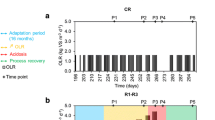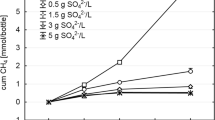Abstract
The microbial community structures of two mesophilic anaerobic chemostats, one fed with glucose, the other with starch as sole carbon sources, were studied at various dilution rates (0.05–0.25 d–1 for glucose and 0.025–0.1 d–1 for starch) during two years continuous operation. In the glucose-fed chemostat, the aceticlastic methanogen Methanosaeta spp. and hydrogenotrophic methanogen Methanoculleus spp. predominated at low dilution rates, whereas Methanosaeta spp. and the hydrogenotrophic Methanobacterium spp. predominated together when dilution rates were greater than 0.1 d–1. Bacteria affiliated with the phyla Bacteroidetes, Spirochaetes, and Actinobacteria predominated at dilution rates of 0.05, 0.1, and 0.15 d–1, respectively, while Firmicutes predominated at higher dilution rates (0.2 and 0.25 d–1). In the starch-fed chemostat, the aceticlastic and hydrogenotrophic methanogens coexisted at all dilution rates. Although bacteria belonging to only two phyla were mainly responsible for starch degradation (Spirochaetes at the dilution rate of 0.08 d–1 and Firmicutes at other dilution rates), different bacterial genera were identified at different dilution rates. With the exception of Archaea in the glucose-fed chemostat, the band patterns revealed by denaturing gradient gel electrophoresis (DGGE) of the microbial communities in the two chemostats displayed marked changes during long-term operation at a constant dilution rate. The bacterial community changed with changes in the dilution rate, and was erratic during longterm operation in both glucose-fed and starch-fed chemostats.
Similar content being viewed by others
References
Tang S Y, Dai Y Z, Liu Z Y. Food IndustrialWastewater Treatment. Beijing: Chemical Industry Press, 2001 (in Chinese)
Abbasi T, Tauseef S M, Abbasi S A. Anaerobic digestion for global warming control and energy generation—An overview. Renewable & Sustainable Energy Reviews, 2012, 16(5): 3228–3242
Ito T, Yoshiguchi K, Ariesyady H D, Okabe S. Identification and quantification of key microbial trophic groups of methanogenic glucose degradation in an anaerobic digester sludge. Bioresource Technology, 2012, 123: 599–607
Fernández A, Huang S, Seston S, Xing J, Hickey R, Criddle C, Tiedje J. How stable is stable? Function versus community composition. Applied and Environmental Microbiology, 1999, 65 (8): 3697–3704
Yu Z T, Schanbacher F L. Production of methane biogas as fuel through anaerobic digestion. In: Singh OV, Harvey SP, eds. Sustainable Biotechnology. Netherlands: Springer, 2010, 106–127
Ferry J G. Fermentation of acetate. In: Ferry JG, ed. Methanogenesis: Ecology, Physiology, Biochemistry & Genetics. New York: Springer, 1993, 304–334
Cheng C H, Hung C H, Lee K S, Liau P Y, Liang C M, Yang L H, Lin P J, Lin C Y. Microbial community structure of a starch-feeding fermentative hydrogen production reactor operated under different incubation conditions. International Journal of Hydrogen Energy, 2008, 33(19): 5242–5249
Angenent L T, Karim K, Al-Dahhan M H, Wrenn B A, Domíguez-Espinosa R. Production of bioenergy and biochemicals from industrial and agricultural wastewater. Trends in Biotechnology, 2004, 22(9): 477–485
Ahring B K, Ibrahim A A, Mladenovska Z. Effect of temperature increase from 55 to 65°C on performance and microbial population dynamics of an anaerobic reactor treating cattle manure. Water Research, 2001, 35(10): 2446–2452
Hori T, Haruta S, Ueno Y, Ishii M, Igarashi Y. Dynamic transition of a methanogenic population in response to the concentration of volatile fatty acids in a thermophilic anaerobic digester. Applied and Environmental Microbiology, 2006, 72(2): 1623–1630
Shigematsu T, Era S, Mizuno Y, Ninomiya K, Kamegawa Y, Morimura S, Kida K. Microbial community of a mesophilic propionate-degrading methanogenic consortium in chemostat cultivation analyzed based on 16S rRNA and acetate kinase genes. Applied Microbiology and Biotechnology, 2006, 72(2): 401–415
Tang Y Q, Shigematsu T, Morimura S, Kida K. Effect of dilution rate on the microbial structure of a mesophilic butyrate-degrading methanogenic community during continuous cultivation. Applied Microbiology and Biotechnology, 2007, 75(2): 451–465
Ovreås L, Forney L, Daae F L, Torsvik V. Distribution of bacterioplankton in meromictic Lake Saelenvannet, as determined by denaturing gradient gel electrophoresis of PCR-amplified gene fragments coding for 16S rRNA. Applied and Environmental Microbiology, 1997, 63(9): 3367–3373
Tang Y Q, Shigematsu T, Ikbal, Morimura S, Kida K. The effects of micro-aeration on the phylogenetic diversity of microorganisms in a thermophilic anaerobic municipal solid-waste digester. Water Research, 2004, 38(10): 2537–2550
Huber T, Faulkner G, Hugenholtz P. Bellerophon: a program to detect chimeric sequences in multiple sequence alignments. Bioinformatics, 2004, 20(14): 2317–2319
Thompson J D, Gibson T J, Plewniak F, Jeanmougin F, Higgins D G. The CLUSTAL_X windows interface: flexible strategies for multiple sequence alignment aided by quality analysis tools. Nucleic Acids Research, 1997, 25(24): 4876–4882
Tamura K, Dudley J, Nei M, Kumar S. MEGA4: molecular evolutionary genetics analysis (MEGA) software version 4.0. Molecular Biology and Evolution, 2007, 24(8): 1596–1599
Bräuer S L, Cadillo-Quiroz H, Yashiro E, Yavitt J B, Zinder S H. Isolation of a novel acidiphilic methanogen from an acidic peat bog. Nature, 2006, 442(7099): 192–194
Zellner G, Messner P, Winter J, Stackebrandt E. Methanoculleus palmolei sp. nov., an irregularly coccoid methanogen from an anaerobic digester treating wastewater of a palm oil plant in north-Sumatra, Indonesia. International Journal of Systematic Bacteriology, 1998, 48(4): 1111–1117
Tarasov A L, Borzenkov I A, Chernyh N A, Belyaev S S. Isolation and investigation of anaerobic microorganisms involved in methanol transformation in an underground gas storage facility. Mikrobiologiia, 2011, 80(2): 184–191
Rivière D, Desvignes V, Pelletier E, Chaussonnerie S, Guermazi S, Weissenbach J, Li T, Camacho P, Sghir A. Towards the definition of a core of microorganisms involved in anaerobic digestion of sludge. ISME Journal, 2009, 3(6): 700–714
Rattanachomsri U, Kanokratana P, Eurwilaichitr L, Igarashi Y, Champreda V. Culture-independent phylogenetic analysis of the microbial community in industrial sugarcane bagasse feedstock piles. Bioscience, Biotechnology, and Biochemistry, 2011, 75(2): 232–239
Allen-Vercoe E, Daigneault M, White A, Panaccione R, Duncan S H, Flint H J, O’Neal L, Lawson P A. Anaerostipes hadrus comb. nov., a dominant species within the human colonic microbiota; reclassification of Eubacterium hadrum Moore et al. 1976. Anaerobe, 2012, 18(5): 523–529
Jiménez N, Barcenilla J M, de Felipe F L, de Las Rivas B, Muñoz R. Characterization of a bacterial tannase from Streptococcus gallolyticus UCN34 suitable for tannin biodegradation. Applied Microbiology and Biotechnology, 2014, 98(14): 6329–6337
Briones A M, Daugherty B J, Angenent L T, Rausch K D, Tumbleson M E, Raskin L. Microbial diversity and dynamics in multi- and single-compartment anaerobic bioreactors processing sulfate-rich waste streams. Environmental Microbiology, 2007, 9 (1): 93–106
Zhang P, Chen Y G, Zhou Q, Zheng X, Zhu X Y, Zhao Y X. Understanding short-chain fatty acids accumulation enhanced in waste activated sludge alkaline fermentation: kinetics and microbiology. Environmental Science & Technology, 2010, 44(24): 9343–9348
Krakat N, Schmidt S, Scherer P. Mesophilic fermentation of renewable biomass: does hydraulic retention time regulate methanogen diversity? Applied and Environmental Microbiology, 2010, 76 (18): 6322–6326
Roest K, Heilig H G, Smidt H, de Vos W M, Stams A J, Akkermans A D. Community analysis of a full-scale anaerobic bioreactor treating paper mill wastewater. Systematic and Applied Microbiology, 2005, 28(2): 175–185
Gagliano M C, Braguglia C M, Gallipoli A, Gianico A, Rossetti S. Microbial diversity in innovative mesophilic/thermophilic temperature-phased anaerobic digestion of sludge. Environmental Science and Pollution Research International, 2015, 22(10): 7339–7348
Braguglia C M, Gagliano M C, Rossetti S. High frequency ultrasound pretreatment for sludge anaerobic digestion: effect on floc structure and microbial population. Bioresource Technology, 2012, 110: 43–49
Nelson K E, Zinder S H, Hance I, Burr P, Odongo D, Wasawo D, Odenyo A, Bishop R. Phylogenetic analysis of the microbial populations in the wild herbivore gastrointestinal tract: insights into an unexplored niche. Environmental Microbiology, 2003, 5(11): 1212–1220
Fernandez A S, Hashsham S A, Dollhopf S L, Raskin L, Glagoleva O, Dazzo F B, Hickey R F, Criddle C S, Tiedje J M. Flexible community structure correlates with stable community function in methanogenic bioreactor communities perturbed by glucose. Applied and Environmental Microbiology, 2000, 66(9): 4058–4067
Nesbø C L, Dlutek M, Zhaxybayeva O, Doolittle WF. Evidence for existence of “mesotogas,” members of the order Thermotogales adapted to low-temperature environments. Applied and Environmental Microbiology, 2006, 72(7): 5061–5068
Kundu K, Bergmann I, Hahnke S, Klocke M, Sharma S, Sreekrishnan T R. Carbon source—a strong determinant of microbial community structure and performance of an anaerobic reactor. Journal of Biotechnology, 2013, 168(4): 616–624
Zumstein E, Moletta R, Godon J J. Examination of two years of community dynamics in an anaerobic bioreactor using fluorescence polymerase chain reaction (PCR) single-strand conformation polymorphism analysis. Environmental Microbiology, 2000, 2(1): 69–78
Author information
Authors and Affiliations
Corresponding author
Electronic supplementary material
Rights and permissions
About this article
Cite this article
Gou, M., Zeng, J., Wang, H. et al. Microbial community structure and dynamics of starch-fed and glucose-fed chemostats during two years of continuous operation. Front. Environ. Sci. Eng. 10, 368–380 (2016). https://doi.org/10.1007/s11783-015-0815-9
Received:
Accepted:
Published:
Issue Date:
DOI: https://doi.org/10.1007/s11783-015-0815-9




